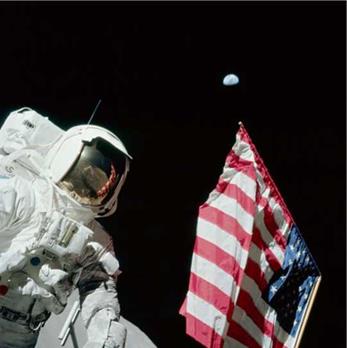Moon Observing. Basics and Book. Tutorial: What. You Need to Know
|
Fig. 1.1 Courtesy of NASA |
J. L. Chen, How to Find the Apollo Landing Sites,
The Patrick Moore Practical Astronomy Series, DOI 10.1007/978-3-319-06456-7_1, © Springer International Publishing Switzerland 2014
The Moon has long held the fascination of mankind. It is the biggest and the brightest object in the night sky. Man has gazed upon the Moon for centuries with awe and imagined journeys there. Great, and not-so-great, literature has been written over the centuries, both prose and poetry, about the Moon. Nature itself has adapted to and has synchronized to the rhythms and timing of the lunar cycle in determining reproduction, migrations, and other organic activities. The contribution of the Moon to life on Earth, and to mankind and his culture is extensive.
Before proceeding to the pictorial portion of this book, there are some basics about the Moon that will help with observing it and appreciating the photos herein.
The Moon is the largest natural moon in proportion to its primary planet in the solar system. It orbits the Earth in an elliptical orbit, with a perigee of 225,741 miles and an apogee of 251,968 miles at an orbital inclination to the ecliptic of 5.125°. This inclination translates to between 18.29° to 28.58° to the Earth’s equator. The Moon has a mean radius of 1,737.1 miles, is spherical in shape, although it is slightly flattened due the gravitational force of the Earth. The lunar mass is
0. 0123 that of Earth. Gravity on the Moon is 0.165.4 g. To launch back into lunar orbit, Apollo Lunar Module (LM) astronauts needed only an escape velocity of 2.38 km/s, as compared to the escape velocity of Earth of 11.2 km/s.
The Moon is the second brightest celestial object that can be seen from Earth, with only the Sun outshining it. At full phase, the Moon shines at -12.74 magnitude. Unlike the Sun, where direct viewing can cause permanent eye damage without proper equipment and eye protection, the Moon can be readily observed safely. The Moon has an albedo of 0.136, which is the ratio of reflected sunlight to the sunlight that hits it. Moonlight does not possess the heat that is characteristic of direct sunlight, and thus cannot cause eye damage. A full Moon can be uncomfortably bright, but it is safe to view. The angular diameter of the Moon for Earth bound observers varies from 29.3 to 34.1 arc minutes.
Commonly thought of as being airless, the Moon possesses a very, very slight atmosphere. Atmospheric pressure varies from a daylight level of 0.0000001 to 0.0000000001 pascals This thin lunar atmosphere consists of argon, helium, hydrogen, potassium, and radon gases.
The Moon is in synchronous rotation with the Earth, thus always showing the same face towards Earth. Because of the Moon’s orbital inclination and it’s elliptical orbit, roughly 64 % of its near face can be seen and mapped from Earth, but not all at one time.











